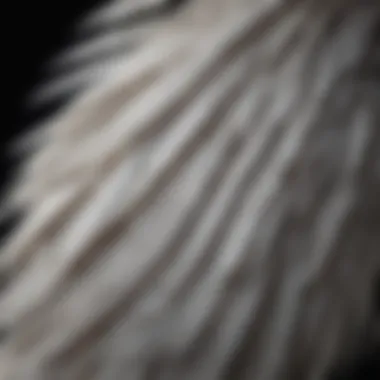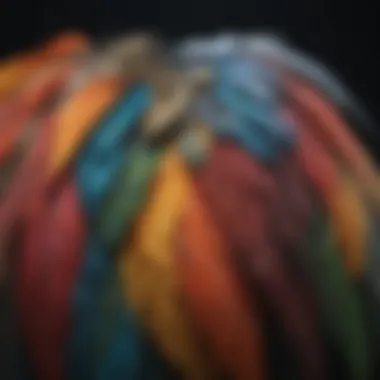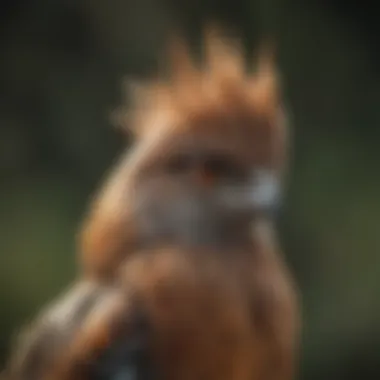Exploring the Role of Long Thin Feathers in Nature


Intro
Long thin feathers manifest intriguing adaptations in various animals, acting as both functional tools and aesthetic accessories. While most may think of birds when talking feathers, their presence extends to the broader animal kingdom. Understanding their role unveils a deeper appreciation for evolution's complexity.
From ensuring a nimble flight to offering protection and contributing to display rituals, these feathers weave a fascinating tale in nature's fabric. As we dissect the intricacies of these structures, we will highlight examples that help illuminate these relationships. Furthermore, the human impact on feathered species raises crucial questions about ecology and conservation efforts, making this subject not only relevant but imperative.
Understanding Feather Structure
To truly appreciate the role of long thin feathers in the animal kingdom, one must first delve into the fundamental building blocks of feathers themselves. When considering the complexity of avian life, understanding feather structure is not merely an academic exercise; it is crucial for grasping the overarching themes of biology, ecology, and even conservation. These intricate features can tell a story of adaptation, functionality, and evolution.
Feathers are not just aesthetic when it comes to birds; their structure plays an integral part in survival. From providing insulation against the chill to facilitating flight, the anatomy of feathers links directly to the environmental challenges species face. Thus, a thorough exploration of feather structure illuminates the broader significance of how these adaptations promote survival.
Anatomy of Feathers
Components of a feather
Feathers are composed of several key components, each playing an essential role in their overall function. The shaft, or rachis, acts as the central vein, providing strength and stability. Meanwhile, the barbs branch off from the shaft, forming a network crucial for maintaining the feather’s shape and efficiency. The tiny hook-like structures called barbules interlock barbs, creating a cohesive surface capable of withstanding air pressure during flight. This arrangement is what makes feathers a beneficial and evolutionarily sound choice in nature.
A unique feature of feather components is the versatility of keratin. This protein is known for its durability and lightweight nature, making it an ideal building block. Its ability to maintain flexibility while bearing loads creates a feather structure that not only looks good but also performs exceptionally in various roles. However, this can be a double-edged sword, as different environments may demand greater resilience, potentially leading to trade-offs in performance.
Types of feather structures
Different types of feather structures contribute differently toward functionality. For instance, contour feathers provide a streamlined shape, essential for flight efficiency and insulation, while flight feathers have a stiff and elongated structure optimized for wing mechanics. Understanding these types can offer insight into the multi-dimensional roles feathers play in an animal's life.
In particular, the unique features of these structures reveal how environmental factors influence feather evolution. For example, birds in warmer climates often have lighter, looser feathers, while those in colder regions benefit from denser, layered structures. The adaptability supported by these feather types becomes particularly interesting when assessing how species transition and adapt to changing environments.
The Composition of Long Thin Feathers
Keratin and its properties
Keratin holds the throne when it comes to feather composition. This fibrous protein bestows feathers with several vital properties: durability, flexibility, and lightweight. Long thin feathers, for instance, can take advantage of these properties to optimize flight capabilities while minimizing energy expenditure. One might say that keratin is the unsung hero of avian anatomy; without it, the complex structure of feathers would collapse in a sea of inefficiency.
Moreover, the unique feature of keratin lies in its adaptability. It can vary in density and arrangement, catering to specific types of species and their habitats. For instance, flight feathers have a more pronounced keratinous structure, allowing for the necessary rigidity during somersaults and dives, while down feathers focus more on insulation. However, the advantageous properties of keratin can also lead to challenges in fluctuating conditions; for example, excessive exposure to moisture can weaken the structure, requiring birds to engage in regular maintenance activities.
Variations in thickness and length
When exploring long thin feathers, variations in thickness and length are particularly significant. The structural integrity of these feathers can vary widely among species, influencing their flight characteristics and adaptability. Thin feathers may reduce drag, enabling agile movements, while thicker feathers often provide better insulation properties, allowing certain birds to thrive in chillier climates.
The unique feature of these variations lies in their evolutionary significance. Adaptive pressures have shaped these feathers to respond to immediate environmental challenges; for example, species that migrate across diverse climates employ a blend of feather thicknesses to maintain optimal performance in both warm and cold regions.
In summary, understanding feather anatomy and composition sheds light on the evolutionary intricacies of long thin feathers in the animal kingdom. Far from being just ornamental, these structures resonate with the essence of survival, allowing species to adapt, thrive, and communicate in their respective ecologies. As we progress through this article, the connection between feather structure and functionality will become increasingly evident, highlighting the delicate balance between morphology and ecological necessity.
Functions of Long Thin Feathers
Long thin feathers play a crucial role in the lives of various animals, especially birds. Their functions are multifaceted, ranging from aiding in flight to insulation and communication. Understanding these functions provides insight into the intricate ways animals adapt to their environments. This section delves into specific aspects like aerodynamic efficiency, thermoregulation, and communication through display, illustrating how these feathers contribute to survival and the delicate balance of ecosystems.
Aerodynamic Efficiency
Role in flight mechanics


Long thin feathers are finely tuned for optimal flight mechanics. The key characteristic of these feathers is their ability to minimize air resistance. This is particularly advantageous for species like the albatross, which can glide for hours with very little wing flap. This design allows birds to cover vast distances with energy-efficient flight patterns.
A unique feature about the role of these feathers is their flexibility, which helps in adjusting wing shape during different flight maneuvers. However, more flexibility could lead to a trade-off in structural integrity. When flying in turbulent conditions, for instance, overly flexible feathers might not withstand the force, leading to potential difficulty in navigation.
Feather arrangement and aerodynamics
The specific arrangement of long thin feathers also plays a critical part in aerodynamics. In birds like the peregrine falcon, these feathers are aligned to streamline airflow, enhancing speed and maneuverability. This arrangement allows the birds to perform agile movements during hunting, showcasing a beneficial design choice for this article.
One unique element here is how the spacing between feathers can affect turbulence and lift. Properly spaced feathers can reduce drag, giving birds an edge in flight. Yet, improper alignment could hinder performance, making feather arrangement a double-edged sword in the world of avian flight.
Thermoregulation
Insulative properties
Long thin feathers are also vital for thermoregulation, helping animals maintain body temperature in varying environments. The key characteristic of these feathers lies in their insulative properties. They trap air close to the skin, providing a layer of warmth without adding significant weight. This is especially crucial for birds that inhabit colder climates.
A unique feature of these feathers is their ability to adapt with a bird's changing physiological needs. For example, during colder months, many species grow thicker layers of down beneath their external feathers. This adaptability highlights why understanding insulative properties is beneficial in this article; it sheds light on animal survival strategies across seasons.
Feather arrangements in different seasons
Another intriguing aspect is how feather arrangements differ across seasons. In summer, birds often shed some of their long thin feathers, reducing insulation needs. Conversely, as winter approaches, birds like jays develop denser feather patterns to combat colder temperatures. This seasonal adaptation is a testament to how these creatures interact with their environment.
The unique feature here is the molt process, which allows birds to renew their feather supply. While this process is essential for maintaining health, it can also temporarily affect a bird's ability to regulate temperature, making it a bit vulnerable during transitional periods.
Communication and Display
Visual signaling in mating rituals
Visual signaling through long thin feathers plays an essential role in mating rituals across species. Male birds often flaunt their elongated feathers to attract potential mates, conveying genetic fitness and health. The key characteristic of this is the visual appeal these feathers provide; they can be vibrant and intricate, which helps in competing for attention during the mating season.
A unique feature in mating rituals is how these feathers are often combined with movement. For instance, the peacock fans out its long feathers and performs a dance to mesmerize females. This dynamic display is not only attractive but also serves to intimidate rivals, ensuring that our discussion remains focused on the multifaceted roles these feathers play in nature's theater.
Use in territorial displays
Use in territorial displays is another significant aspect of long thin feathers. Many bird species employ their feathers as a form of intimidation to ward off intruders. The key characteristic here is the sheer size and color vibrancy, which signal strength and dominion over a particular area.
A unique feature in this context is the timing of displays. Some birds flare their feathers at dawn, an advantageous choice to announce their presence when daylight casts light on their plumage. However, if a bird is outnumbered or outmatched, the display can backfire, prompting confrontations that could end badly for the defending bird.
In summary, long thin feathers are not just ornamental; they serve essential functions in aerodynamics, thermoregulation, and communication, weaving a rich tapestry of interactions in the animal kingdom.
Evolutionary Perspectives
Understanding the evolutionary perspectives of long thin feathers unveils a crucial chapter in the story of animal adaptation and survival. The way these feathers have developed through time reveals much about the pressures species face within their environments. Looking at evolutionary factors, we can see how natural selection and phylogenetic studies provide insights into both past and present animal forms. This section not only highlights the richness of avian and other species but also delves into why these adaptations are critical for living successfully in various habitats.
Adaptive Evolution of Feathers
Natural selection factors affecting feather morphology
Natural selection plays a significant role in determining feather morphology, particularly with long thin structures. The variation in feather design often reflects the demands of flight, insulation, or display. For instance, birds that soar in high altitudes tend to have feathers that are longer and thinner, facilitating better aerodynamics. This specific choice is beneficial because it allows more streamlined movement through the air, reducing energy expenditure. One unique feature here is how these adaptations can occur rapidly in response to environmental changes, like shifting climates. However, there's a catch—while adaptations may benefit flight capabilities, they can also make birds more susceptible to certain threats, like predators in specific habitats.


Phylogenetic studies on feather development
Phylogenetic studies offer a lens into the complex evolution of feathers, tracing back how these structures have emerged in various lineages. What makes this particularly fascinating is the ability to reconstruct evolutionary paths and understand the significance of feather development over time. For instance, some evolutionary branches of birds that evolved under different ecological pressures have developed distinct feather forms, each serving unique functions. A notable aspect of this study is its capacity to reveal historical relationships between species. The unique feature of phylogenetic studies is their ability to explain not just how feathers have changed, but why they have adapted in such diverse manners. Yet, this can present challenges, as tracing exact lineages can sometimes lead to dilemmas about classification and designation in the avian family tree.
Long Thin Feathers in Flightless Birds
Evolutionary significance of reduced flight capabilities
Long thin feathers in flightless birds illustrate an intriguing evolutionary narrative. The significance of these feathers often lies in their dual role; while they no longer assist in flight, they serve other functions like insulation and mating display. This adaptation does not stem from a lack of necessity but rather represents a shift in ecological focus. The key characteristic here is that, instead of aiding in airborne travel, these feathers contribute to thermal regulation. A compelling unique feature of flightless birds is how these feathers can create structures that allow them to survive in varied climates. However, there’s an inherent disadvantage as well—without the ability to fly, these birds rely on other means for protection which can limit their geographic distribution.
Comparative anatomy with flying relatives
Comparative anatomy between flightless birds and their flying relatives is essential for understanding feather evolution. This examination highlights how different ecological demands lead to diverse feather adaptations. Long thin feathers in flightless species often contrast sharply with those of birds that rely on flying for their survival. A key finding is that while flying birds often have robust, strong feathers designed for lift and speed, their flightless counterparts favor different characteristics focused on other survival strategies. One notable advantage here is the opportunity to study how anatomical structures adjust in response to natural selection pressures. Yet, the drawback is that it sometimes oversimplifies broader anatomical commonalities in birds, leading to misconceptions about their capabilities and behaviors as a whole.
Diversity in Feathered Species
The exploration of long thin feathers reveals not just their beauty but their significant functional diversity across the animal kingdom. Different birds and animals exhibit an astounding variety, each adapted to their environments, behaviors, and survival strategies. Understanding this diversity helps to appreciate how these feathers contribute to ecological roles and evolutionary processes.
Species equipped with long thin feathers often have unique adaptations that enhance their survival. From voting ritual displays to efficient gliding mechanics, these feathers serve multiple purposes beyond mere aesthetics. Recognizing the rich tapestry of feathered species also enriches our understanding of environmental health and biodiversity. This section will focus on two main areas: birds that showcase remarkable long thin feathers and other animals that feature feather-like structures, each playing their role in their ecosystems.
Birds with Notable Long Thin Feathers
Species of interest
When we consider birds with long thin feathers, the Greater Bird-of-Paradise stands out remarkably. Known for its extravagantly long tail feathers, it exhibits some of the most vibrant displays during mating rituals. The characteristic of these feathers allows them to sway gracefully, capturing the attention of potential mates. Their coloration reflects a mix of iridescence and vibrancy, making them not just visually appealing but also critical in the attraction phase of courtship.
The unique feature of the Greater Bird-of-Paradise is its exceptionally elongated tail feathers, which can extend more than half a meter. This feature, while advantageous in courtship, encounters the disadvantage of requiring energy and skills for efficient flight. Such traits underline the delicate balance in evolutionary traits, where display attractiveness can sometimes compete with unencumbered navigation.
Functional adaptations across species
Now, if we look at functional adaptations, the Peacock is another compelling example. Its long thin feathers serve as an extraordinary display during mating season, showcasing a vivid array of colors and patterns. Peacocks use their ornate tails to impress peahens, enhancing reproductive success.
What sets the peacock's adaptation apart is not just the dazzling spectacle but its remarkable structural composition. The barbs in the feathers create micro-scale iridescent effects that reflect light at various angles, making them visually striking. However, the flip side is that their ornamental tail can hinder agility, particularly in dense habitats. Such adaptations highlight the intersections between attraction and survival—how beauty indeed endows the burden of responsibility for flight and maneuverability.
Long Thin Feathers in Other Animals
Other species with feather-like structures
Venturing beyond birds, we discover that other species also emulate structures akin to long thin feathers. The Bristle Worm, for example, possesses long, hair-like structures called chaetae, which serve various functions including locomotion and in some cases, even respiration. Unlike feathers, these structures help bristle worms navigate through sediment, displaying how diverse biological structures can be.
These chaetae resemble feathers in their length and form but differ in purpose, demonstrating that nature often uses similar strategies across species. Their unique feature is the ability to anchor into substrates, thus aiding in stability and movement under challenging conditions. Despite the distinct differences in origin and use, their feather-like appearance illustrates convergent evolution in adaptations for survival.
The role of similar adaptations in non-avian species
Focusing on non-avian species reveals further fascinating parallels; the Tropical Heliconian Butterfly also flaunts elongated scales that act similarly to feathers. These scales not only help in flight but contribute to thermal regulation, adding another layer to the complexity of their adaptations. The visual appeal of these butterflies mirrors that of feathered displays in birds—showing how various species exploit similar evolutionary strategies for visual signaling. As with other adaptations, these scales can have drawbacks; they may require more energy to maintain and can diminish the effectiveness of flying in high winds.
In summary, the diversity in feathered and feather-like species underscores significant themes in adaptation, survival, and ecology. As we explore how these feathers facilitate aerial prowess or displays of dominion, we not only unveil the beauty of nature’s designs but emphasize the need for proper conservation strategies to protect these intricate systems.
Impact of Human Activity on Feather Morphology


Human activity has had a profound impact on the natural world, and feather morphology in various species is no exception. This section examines how development, habitat destruction, and conservation efforts interplay to shape the evolution and functionality of long thin feathers in the animal kingdom. It's essential to understand these dynamics, as they reveal the broader ecological implications of our actions.
Habitat Loss and its Consequences
Effects of urbanization on feathered species
Urbanization acts like a double-edged sword; while it builds cities and infrastructure, it often cuts deep into wildlife populations. The encroachment of urban areas leads to habitat fragmentation, which can severely disrupt the life cycles of bird species. Long thin feathers, crucial for flight, thermoregulation, and display, can be compromised due to these changes. The loss of natural habitats makes it challenging for birds to find resources and mates, leading to eventual declines in populations.
One key feature of urbanization's impact is the alteration of available food sources, which affects feather health. Without adequate nutrition, feather growth suffers, and damaged feathers may no longer serve their intended purpose. Additionally, urban environments often present increased dangers such as vehicle strikes and window collisions. This results in a notable increase in mortality rates among bird species.
"Birds adapt to survive, but the pace of urbanization can outstripping their ability to change as conditions shift."
Case studies on habitat management
Case studies in habitat management provide a window into how proactive strategies can mitigate some effects of urbanization. For instance, initiatives that restore native vegetation or create green corridors have shown to facilitate movement and nesting opportunities for feathered species. This approach allows long thin feathers, integral to many birds' flight mechanics, to function more effectively.
A unique feature of successful habitat management programs is their tailored strategies to the specific needs of local species. These programs often rely on community involvement and awareness. When communities engage in conservation, the success rates of these projects greatly increase. However, challenges remain in sustaining these habitats amidst growing urban centers.
The Role of Conservation Efforts
Conservation strategies for affected species
Conservation strategies provide a lifeline for feathered species affected by human activity. Effective plans often combine habitat preservation, legal protections, and public engagement. For example, the development of protected areas that prioritize native flora can help maintain the environments necessary for birds to thrive. These strategies not only focus on safeguarding existing habitats but also emphasize restoration efforts, allowing long thin feathers to regain their vital functions in ecosystems.
A notable characteristic of these efforts is their adaptability. Conservation strategies are evaluated and revised based on ongoing research and results, making them responsive to the needs of various species. As such, these strategies serve not only immediate need but also align long-term objectives aiming at ecological balance.
Success stories in rehabilitation
Some inspiring success stories highlight how concerted conservation efforts lead to positive outcomes for feathered species. One prominent case is the American bald eagle, whose populations rebounded from the brink of extinction due to dedicated conservation work. This included legal protections and habitat enhancement efforts that supported the survival of their long thin feathers, essential for soaring and hunting.
The strength of these success stories lies in their ability to motivate and inspire. They provide tangible proof that interventions can yield results. However, they also serve to remind us that sustaining these gains requires ongoing effort and commitment from all stakeholders in conservation. The advantages are clear: successful rehabilitation aids not just individual species but helps maintain the biodiversity and health of ecosystems crucial for all life forms.
The End and Future Directions
In summarizing the intricacies of long thin feathers, it’s essential to emphasize their multifunctionality in the animal kingdom. From enabling efficient flight mechanisms to facilitating thermoregulation, these feathers are no one-trick ponies. The conclusions drawn from this analysis point to the significant ecological roles that long thin feathers play across diverse species.
Summation of Key Points
Recap of morphological significance
Discussing the morphological significance of long thin feathers reveals a fascinating tapestry of adaptation. These structures are slender yet sturdy, tailored to fulfill various roles—such as flight, warmth, and display. Their shape is not just an aesthetic choice; it’s a key characteristic that benefits species adapted to specific environments. Long slender shapes reduce drag during flight, while their unique arrangement aids in insulation and camouflage. Understanding these features contributes immensely to our grasp of evolutionary biology and animal behavior, making it indispensable for anyone investigating ecological dynamics.
Implications for future research
The implications for future research present exciting possibilities. Researchers have a unique opportunity to explore how environmental change is reshaping feather structures. This area is particularly beneficial as it intersects with conservation efforts, allowing scientists to study how species adapt or fail to adapt to shifting climates and habitats. A focus on this aspect will not just shed light on feather biology but also deepen our understanding of broader ecological impacts. However, this path is not without challenges, as collecting data across various ecosystems requires interdisciplinary collaboration.
Further Studies on Long Thin Feathers
Emerging research areas
Emerging research areas are ripe for exploration, particularly the influence of urbanization on the morphology of long thin feathers. This subject offers a dual perspective: it highlights how habitat modification impacts animal adaptation while also revealing potential consequences for biodiversity. This topic is beneficial not only for scientists but also for conservationists who seek to create effective management plans for urban wildlife. Moreover, studying these adaptations can provide critical insights into the dynamics of climate change and its hidden effects on avian life.
Interdisciplinary approaches to understanding functions
Finally, interdisciplinary approaches to understanding the functions of long thin feathers can pave the way for unprecedented discoveries. Integrating fields such as material science, ecology, and behavioral biology can unlock new frameworks for research. This diversification of knowledge is beneficial as it allows scientists to collaborate across traditional boundaries, enhancing innovation. The challenge, however, is maintaining a cohesive dialogue among varied disciplines to create a comprehensive understanding of these remarkable structures.
"The study of long thin feathers not only enriches our understanding of avian species but also links to a broader preservation narrative that is crucial in today’s world."







